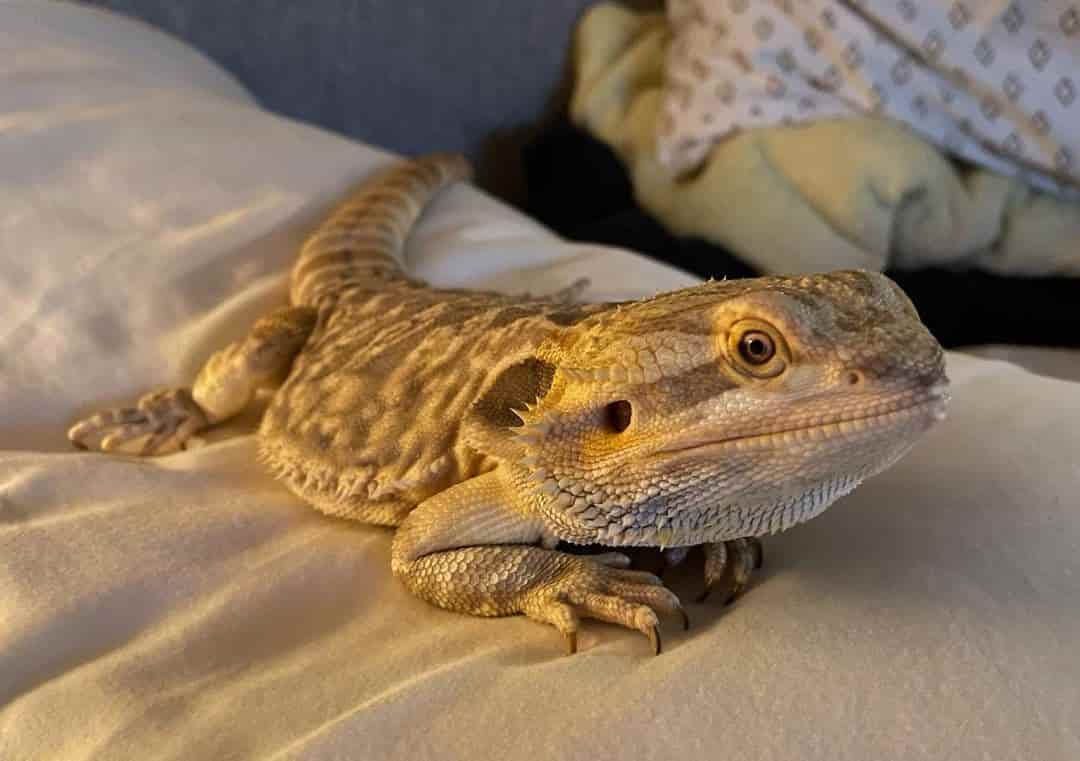As a bearded dragon owner and lover, I’ve become attuned to changes in my beardie’s mood and can tell the first signs of my beardie getting angry.
It’s important for you to learn when bearded dragons get angry too, as unchecked aggression in beardies can lead to various health and behavioral problems, not to mention a strain on your relationship with your beloved beardie.
In this guide, we’ll help you understand the causes of anger in your beardie, what behavioral signs will let you know that your bearded dragon is ticked off, and ways to calm them down.
Ready? Let’s dive in!
Table of Contents
Understanding Aggression in Bearded Dragons
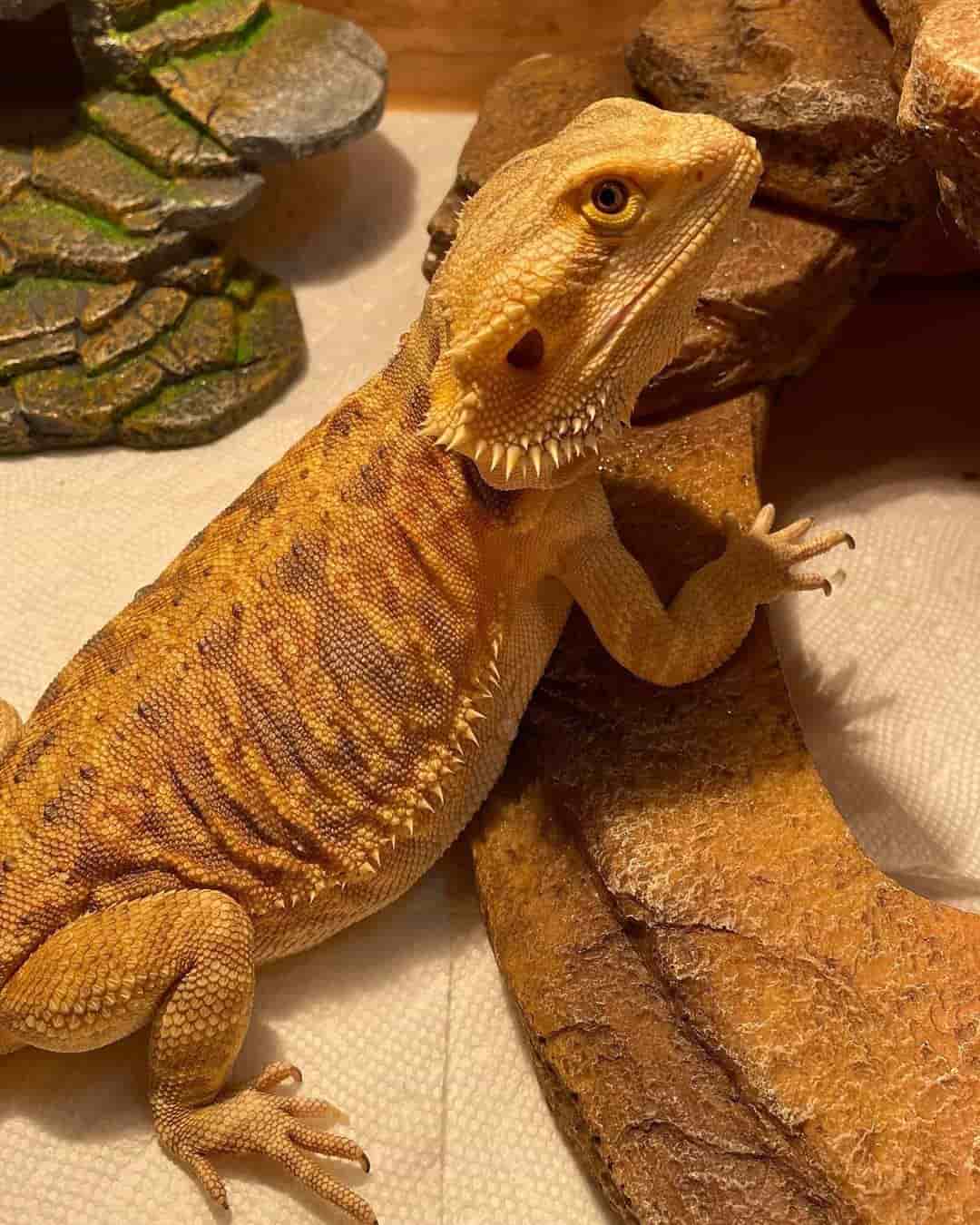
When talking about an aggressive bearded dragon, understanding its roots is our first step. We’ll delve into the common triggers and causes, which range from territorial instincts to anxiety. To pacify an angry bearded dragon, you must comprehend the reptilian mind.
Common Triggers and Causes of Aggression
An aggressive bearded dragon is often a response to a perceived threat. As we unfold this segment, we’ll analyze territorial, fear-based, and defensive aggression and identify key behavioral signs aiming to decode your pet’s emotional landscape.
Territorial Aggression
The first thing you need to know about bearded dragons is that they are solitary creatures by nature. When it comes to their space, they are fiercely territorial. An intrusion, real or perceived, can incite what we call territorial aggression.
Whether it’s a new pet in the house, a rearranged terrarium, or simply an overly curious child’s hand, your dragon might interpret it as violating their domain and respond aggressively to safeguard its territory. Understanding this territorial nature can help us mitigate confrontational situations.
Fear-Based Aggression
Fear is a potent trigger. Imagine how you would feel if a towering creature unexpectedly reached your home. Fear-based aggression occurs when a bearded dragon perceives a threat, even if there isn’t one.
Loud noises, sudden movements, or unfamiliar people or pets can alarm your dragon, causing them to become a mad bearded dragon. Recognizing and minimizing these fear-inducing factors can significantly help in reducing aggression.
Defensive Aggression
Defensive aggression is a response to perceived threats, which can be anything from a new toy in their habitat to a visit to the vet. Your typically friendly dragon will become an aggressive bearded dragon and may puff up, hiss, or even bite in this situation.
It’s their survival instinct kicking in, a primal response that says, “Back off, or I’ll fight.” As caregivers, understanding this kind of aggression can help us avoid unnecessary stressors and ensure we approach our dragon in a way that doesn’t ignite its defenses.
Behavioral Signs
The fascinating thing about bearded dragons is that they are expressive, even though they can’t communicate like mammals. Behavioral signs of aggression include darkening of the beard or body, puffing up, hissing, tail whipping, and even biting in extreme cases.
A dragon might also wave its arm in a circular motion, a common sign of submission, yet, it could also suggest distress. These behavioral signs are the dragon’s way of saying, “I am not happy!”
Recognizing these signs and responding appropriately is crucial in maintaining a healthy and happy relationship with your dragon.
What is Making My Bearded Dragon Angry?
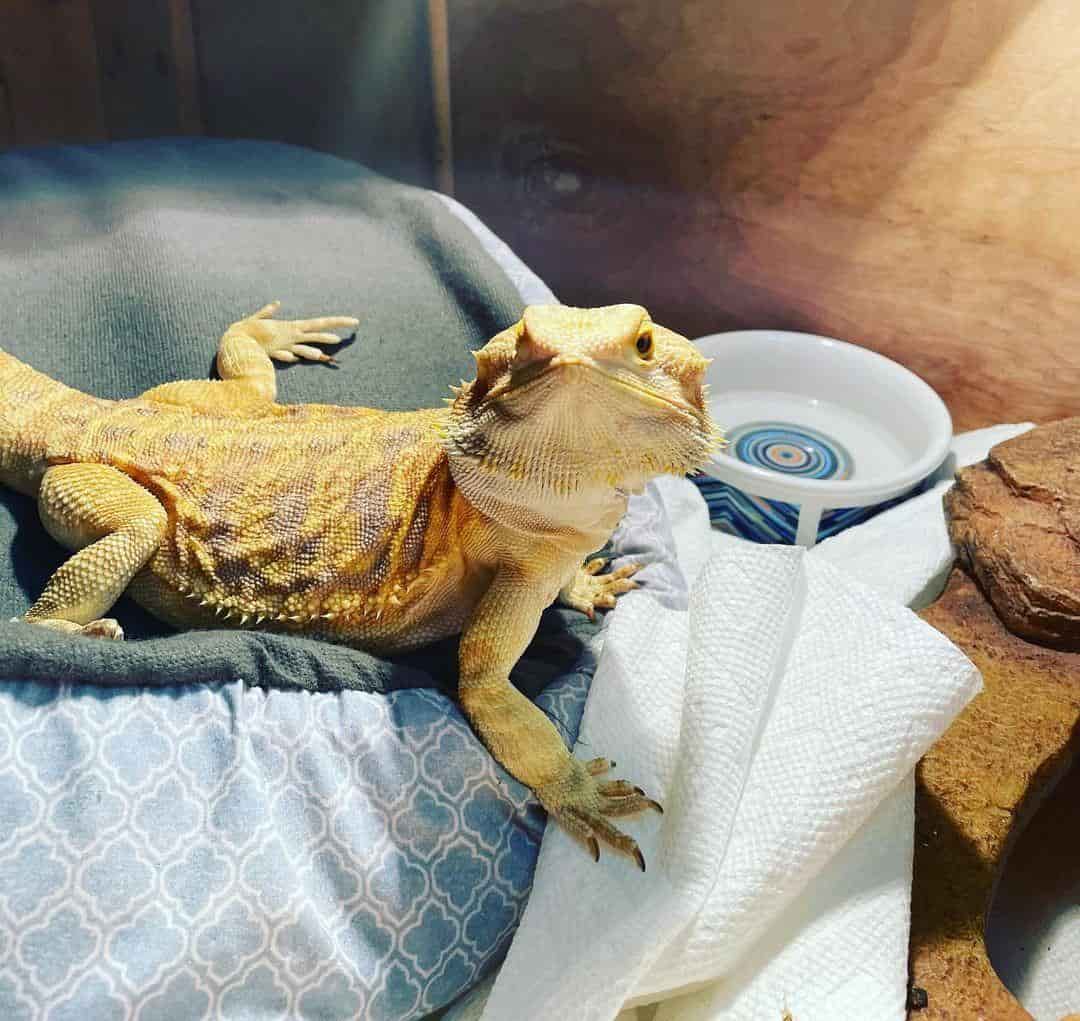
Bearded dragons have a range of emotions, and anger or agitation is certainly one of them. Understanding what makes a bearded dragon mad and triggers this mood change is crucial to ensure a loving and stress-free environment.
Let’s dive into the probable causes that may make your dragon agitated.
Territorial Instincts
In the wild, bearded dragons are solitary creatures and have strong territorial instincts. The enclosure or cage where your dragon lives are perceived as its territory.
They are protective of their space, and any intrusion, like the addition of another pet or a sudden change in their living conditions, can incite territorial aggression. So, to keep your dragon calm, ensure its personal space is respected.
Stressful Environment
A peaceful environment is crucial for a happy dragon. Loud noises, constant handling, bright lights, or an overactive household can cause significant stress.
Even seemingly minor changes like moving their enclosure, introducing new decorations, or changing their feeding routine can upset your pet.
Avoid drastic changes and ensure your dragon’s surroundings are as calm and steady as possible to avoid making your bearded dragon mad.
Improper Handling
Bearded dragons require gentle and respectful handling. Quick, sudden movements can startle them. Additionally, they are not fans of being held too tight or being touched on their sensitive areas like their bellies or tails.
Consistent and careful handling that respects their boundaries can help prevent aggression. So, remember to always handle your dragon calmly, slowly, and gently.
Health Issues
Like any other pet, a sick or physically uncomfortable bearded dragon may express their discomfort through aggression. Common health problems, such as parasitic infections, impaction, or metabolic bone disease, can cause significant distress and pain.
Regular veterinary check-ups and prompt attention to changes in behavior or physical condition can ensure your dragon stays healthy and happy.
Fear or Insecurity
Bearded dragons, despite their tough exterior, can feel scared or insecure. Sudden changes, new environments, or perceived threats can instill fear. Additionally, they might feel insecure due to the lack of hiding spaces in their enclosure.
Providing plenty of hidey-hole and ensuring a stable environment can help your pet feel secure.
Mating Season
Hormonal changes during the mating season can make a usually calm dragon display aggression. Male dragons, in particular, can become territorial and aggressive, showing signs like head bobbing, puffing up, or even biting.
Understanding this biological change and giving your dragon the necessary space can help manage its aggression during this period.
Behavioral Signs of an Angry-Bearded Dragon
Recognizing signs of distress or agitation in your bearded dragon can be a game-changer. By tuning into their behavior, you can quickly address any issues and keep your scaled friend in their best form.
Let’s understand the signs indicating your bearded dragon might feel angry.
Aggressive Body Language and Posturing
Aggressive body language is one of the most common signs of an aggressive bearded dragon. This might include puffing up their body or beard to appear larger, opening their mouth wide in a threatening manner, or stamping their feet.
These postures are clear indicators that your bearded dragon is not feeling content.
Arm Waving
Arm waving is a peculiar behavior where your dragon will lift one of its front legs and wave it in a circular motion. While it can indicate submission, it can also be a sign of stress or fear, especially if accompanied by other symptoms of agitation.
Head Bobbing
Head bobbing can mean several things in bearded dragon language, depending on the speed and intensity. Slow head bobs signify dominance, while rapid head bobs indicate aggression or distress. If your bearded dragon is frequently head bobbing, it may indicate anger or agitation.
Tail Whipping or Lashing
Tail whipping is a defensive mechanism a mad bearded dragon might employ when feeling threatened. It’s a clear sign that your dragon is upset and demands space and calm to cool down.
Biting Behavior
While bearded dragons are generally docile, a stressed or fearful dragon might resort to biting. If your usually calm dragon tries to bite, it’s a clear indication that they’re angry or distressed.
Hiding or Seeking Isolation
Retreating to a hiding spot or seeking isolation is a common reaction in stressed or angry bearded dragons. If your dragon is spending more time hiding than usual, it might be feeling upset or stressed.
Increased Agitation or Restlessness
It might be agitated if your dragon is pacing around their tank, scratching the glass, or seems more restless than usual. Restlessness can be a sign of various issues, including stress, discomfort, or illness.
Changes in Appetite and Eating Patterns
One of the key indicators of an upset or agitated bearded dragon is a shift in its appetite and eating patterns. Here’s what you need to know about these changes and what they might mean for your pet’s emotional state.
Loss of Appetite
A noticeable decrease in your bearded dragon’s appetite can indicate something is amiss. Stress or discomfort can lead to loss of appetite, making your pet refuse food they would typically devour with enthusiasm.
A significant or prolonged appetite change is a clear sign your dragon is upset and may warrant a visit to the vet.
Food Aggression
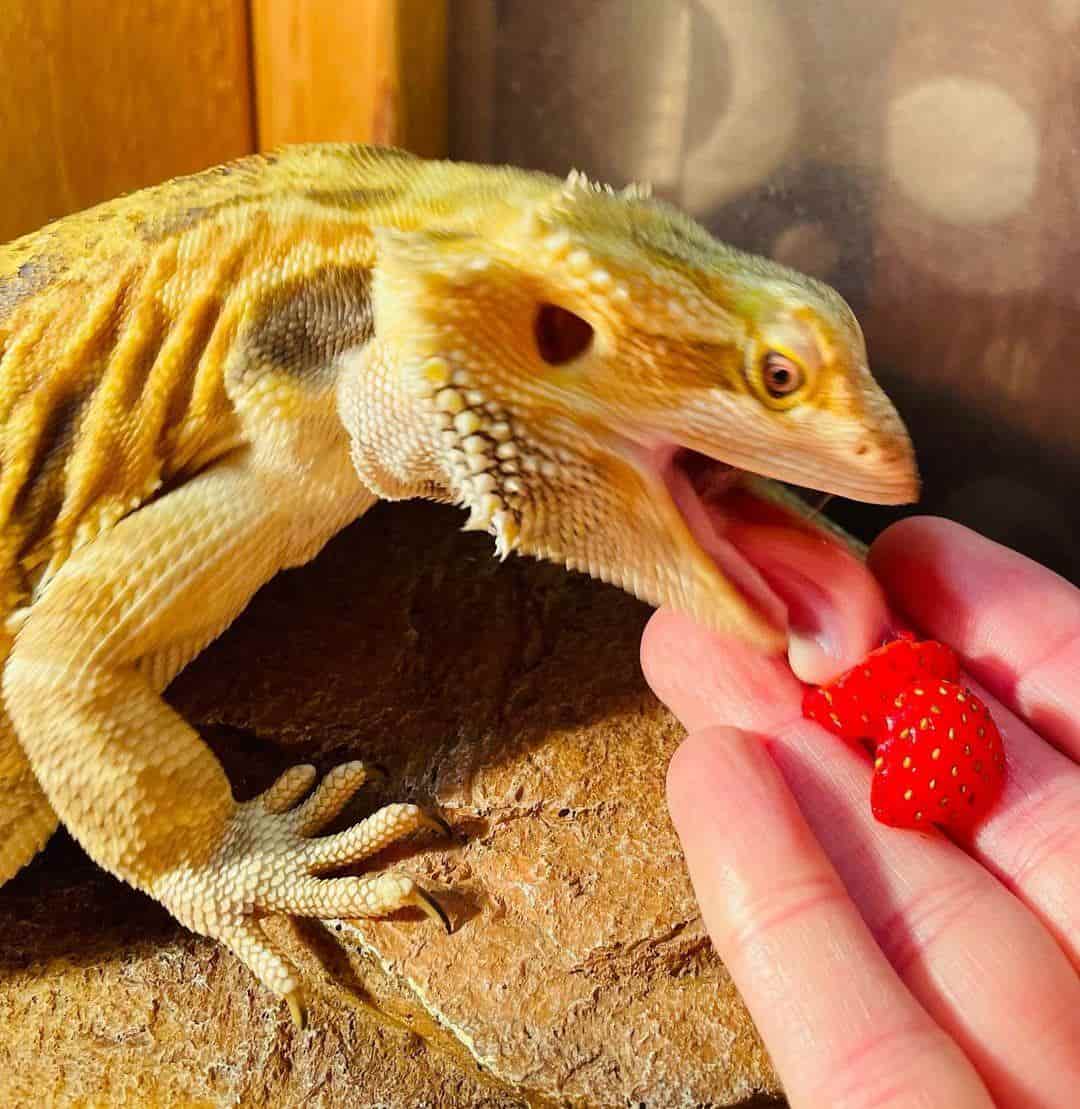
If your usually calm dragon suddenly starts displaying aggressive behavior during feeding times, it might be a sign of distress.
Food aggression in bearded dragons can manifest as rushing towards the food, snapping at the feeding tongs, or showing defensive posturing when you approach food. These could all be signs of a bearded dragon when mad or under stress.
Unusual Chewing or Grinding of Teeth
Chewing or grinding of teeth, also known as bruxism, is a lesser-known sign of distress in bearded dragons. If you notice your dragon grinding their teeth or chewing unusually, it could indicate discomfort, stress, or even health issues like gastrointestinal pain.
Changes in Physical Appearance
Beyond behavioral cues, an angry bearded dragon can also have physical changes. Observing these transformations can help you spot distress signs in your dragon early on. Let’s take a look at some of these physical changes.
Darkening or Black Spots
If your bearded dragon’s skin starts showing darkening or black spots, especially around its beard, it may be a sign of distress or agitation. Darkened skin or a “black beard” is a common sign of stress or discomfort in bearded dragons, indicating that your pet may be upset.
Flattening or Inflating of the Beard
A bearded dragon often flattens or inflates its beard as a sign of aggression or defense. A flattened beard can make them appear larger and more intimidating, usually when they feel threatened.
On the other hand, an inflated or puffed-up beard might indicate distress or fear, hinting at your dragon’s agitated state.
Puffed-up Body
Similar to an inflated beard, a bearded dragon may puff up their body when feeling threatened, uncomfortable, or angry. Like many others, this behavior is an attempt to appear gigantic and more intimidating to potential threats.
A consistently puffed-up body signifies a distressed or aggressive bearded dragon.
Vocalizations and Audible Signs
While bearded dragons aren’t typically known for their vocalizations, they can produce a range of sounds when agitated. Let’s decode these audible signs to understand your pet’s emotional state better.
Hissing
Hissing is a clear indication of an angry bearded dragon. They usually hiss when they feel threatened or want to be left alone. If you encounter your dragon hissing, giving them space to calm down before trying to interact again is advisable.
Puffing of the Throat or Puffing of Air
Puffing of the throat or exhaling air forcefully is another sign of distress in bearded dragons. This behavior is often accompanied by other signs of distress, like a black beard or flattened body. The puffing action is a defense mechanism intended to ward off perceived threats.
Chirping Noises
Chirping or soft squeaking sounds can also indicate discomfort or fear in bearded dragons. While these sounds can sometimes be related to positive interactions, like communication between two dragons, frequent or panicked chirping might point towards a stressed or upset dragon.
Defensive Behaviors
When faced with stress or discomfort, bearded dragons, like many animals, respond with defensive behaviors. Identifying these signs is key to ensuring your pet’s well-being. Let’s dive into these defensive behaviors.
Attempting to Flee or Hide
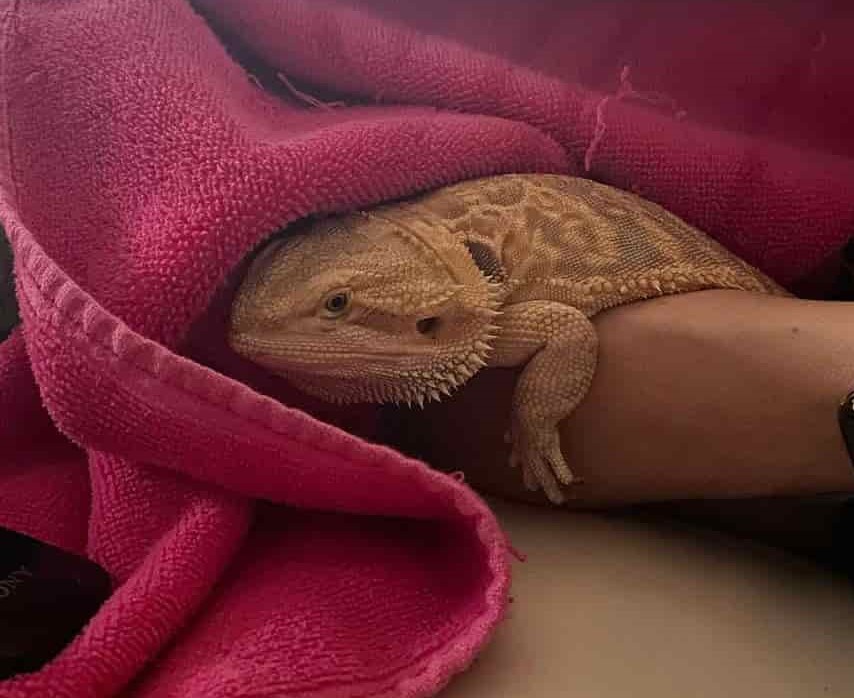
A common defensive behavior is when a bearded dragon attempts to flee or hide. This usually occurs when they feel threatened or uncomfortable. If your dragon frequently tries to escape or spends excessive time hiding, it might be distressed.
Displaying Defensive Postures
Defensive posturing is a clear signal of a mad bearded dragon or feeling threatened. This can include puffing up their body or beard, flattening against the ground, or displaying their mouth wide open. These postures aim to make them appear larger or more threatening to scare off potential threats.
Aggressive Tail Whipping or Slapping
Tail whipping or slapping is a clear sign that your dragon is on the defensive. This can occur when they feel threatened or scared, with the tail acting as a tool to ward off perceived threats.
Recognizing these defensive behaviors is crucial to understanding and addressing your bearded dragon’s emotional state. Remember, these behaviors are natural responses to stress or fear and indicate that your pet needs reassurance and comfort.
Calming Methods and Behavioral Strategies for an Angry-Bearded Dragon
Addressing your aggressive bearded dragon involves a combination of understanding its behavior and implementing calming strategies. Let’s explore some methods to help soothe an angry bearded dragon.
Move Away Slowly
If your bearded dragon exhibits signs of aggression, it’s advisable to move away slowly. Abrupt movements can escalate their distress. A slow, gentle retreat reassures them that they are not under threat.
Remain Calm and Assertive
Your bearded dragon can sense your emotions, so remaining calm and assertive is crucial. Avoid reacting negatively to their aggression, as it can exacerbate the situation. Instead, maintain a calm demeanor to help ease their distress.
Provide a Suitable Habitat
Providing a suitable habitat is essential to keeping your bearded dragon calm and stress-free. This includes an adequately sized tank, the right temperature and humidity levels, and a secure hiding place. A proper habitat caters to their needs and helps maintain their overall comfort and well-being.
Offer Appropriate Enrichment and Exercise
Regular exercise and enrichment activities benefit a bearded dragon’s physical and mental health. Offering a variety of toys and activities can keep them engaged and minimize boredom, reducing the likelihood of aggression.
Professional Help If Necessary
Mad bearded dragon continues to display aggression despite your best efforts, it’s time to seek professional help. Veterinarians or professional reptile handlers can provide expert advice and intervention to ensure your pet’s well-being.
Conclusion
As we unravel this journey of understanding your bearded dragon when mad, remember that compassion, patience, and consistency are keys to mitigating their aggression.
With the insights shared, you’re now better equipped to interpret your dragon’s behavior, ensuring a harmonious and fulfilling bond with your feisty friend. Always remember, an angry bearded dragon is not a bad dragon; it’s just a dragon trying to communicate.
FAQs
Which gender of a bearded dragon is more aggressive?
Both male and female bearded dragons can display aggressive behaviors. However, males are often considered more territorial and may show more aggression, especially during the mating season.
How not to handle a bearded dragon?
It’s best to avoid handling a bearded dragon when they’re displaying signs of aggression. Also, abrupt or forceful handling can cause stress, so always approach them slowly and gently, and avoid picking them up from above as it can make them feel threatened.
Does it hurt if a bearded dragon bites you?
Yes, a bearded dragon bite can be painful, especially from an adult dragon. Although not typically dangerous, it’s recommended to clean the area thoroughly and seek medical advice if the bite is deep or causes significant pain.
How to calm a bearded dragon?
To calm a bearded dragon, maintain a stable and quiet environment, handle them gently, and provide a comfortable habitat with proper temperature and lighting.
Alina Hartley is a small-town girl with a ginormous love of bearded dragons. It all started with Winchester, a baby bearded who was abandoned at the shelter by his former owners because of a birth defect that caused one front leg to be shorter than the other. Alina originally went to the shelter looking for a guinea pig, but one look at Winchester and it was love at first sight. From that day on, Alina has dedicated her life to learning everything she can about bearded dragons. She loves helping new beardie parents start their incredible journey with these magnificent reptiles.
Follow her on:
LINKEDIN
TWITTER.
Read her latest articles HERE
Learn more about her HERE.

